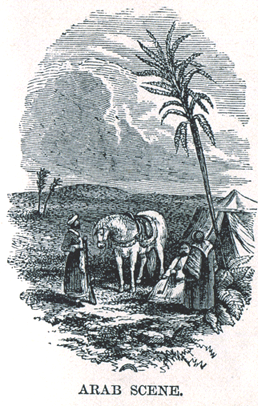
In a previous post I continued a thread from an 1879 school geography text. At the time much of the Arab World was under the control, nominal at times, of the Ottoman Empire. This text divided the Ottoman holdings into those in Asia, discussed below, and those in Europe, to be given in a separate post.
1. Arabia is a great plateau, abounding in deserts, and possessing but few fertile districts, except along the coast. Its area is about 1,000,000 square miles.
2. The Climate is the dryest in the world, rain seldom falling anywhere, and the heat being intense, especially in the lowlands and deserts.
Arabia has been divided into three parts: – ARABIA FELIX, happy or fertile; ARABIA PETRAE, stony; and ARABIA DESERTA, desert. The fist of these divisions borders on the Persian Gulf, the Indian Ocean, and the Red Sea; the second lies on the northeastern shore of the Red Sea; and the third includes all of the central portion of the country. The cultivated tracts are generally near the mountains, from which rivers descend in the rainy season and thus enrich the soil. Numerous oases re found in the desert regions.
3. The Inhabitants comprise three classes; namely, the people of the towns, the tillers of the soil, and the wandering tribes called Bedouins. The latter dwell in tents, subsisting on their flocks and herds, or upon plunder.
4. The Chief Products are dates, coffee, and some kinds of grain. Camels, horses, donkeys, sheep, and goats are extensively reared. Arabia is especially noted for its horses, and supplies nearly all the camels required for the caravan trade of western Asia.
5. Manufactures are carried on to some extent, the chief articles being camelots, silks, woolens, and earthenware.
6. Commerce is carried on from the ports of the Red Sea and Persian Gulf; the Chief Exports are coffee, gums, and perfumes. The Pearl-fisheries of the Persian Gulf are very extensive and valuable.
7. The Government is exercised principally by the chiefs of the tribes, called Sheiks. Hedjaz and Oman is under the rule of the Sultan of Muscat. Nedjed is the kingdom of the Wahabees.
8. The Chief Cities are the following:
Muscat is the chief emporium in eastern Arabia; and noted for its intense heat, and it large exportation of dates, hides, horses, and donkeys. Population, 60,000.
Sana, capital of Yemen, or Happy Arabia; has a very great trade in coffee, numerous splendid mosques, and is elevated about 4,000 feet above the sea. Population, 45,000.
Mecca, the birth-place of Mohammed, contains the holy shrine, and is visited yearly by thousands of pilgrims. Population, 45,000.
Aden, a fortified sea-port belonging to Great Britain, is the station for steam vessels plying between India and Suez, and an important coal dépôt. Population, 30,000.
9. Medina, the burial-place of Mohammed; Jiddah, the port of Mecca; Mocha, celebrated for its coffee, and Riad, the capital of Nedjed, are the most important of the remaining towns.
10. ASIATIC TURKEY, the principle part of the Ottoman Empire, consists of the mountain regions of Asia Minor and Armenia, the Plain of the Euphrates and Tigris, and the table-land of Syria. Its area, with Turkish Arabia, is about 675,000 square miles.
This region is perhaps the most interesting in the world. The site of the Garden of Eden is supposed to have been in Armenia; and it is thought that the ark rested on Mt. Ararat, after the deluge. Here also were the first civilized nations, the most ancient empires, and the oldest cities, some, as Babylon and Nineveh, of vast size and magnificence.
11. The Inhabitants consist principally of Turks; but about one third are Armenians, Greeks, Arabs, Jews, etc. Mohammedanism is the prevailinChief Agricultural Products are grain, tobacco, cotton, opium, and fruits, such as olives, figs, and grapes.
13. The Manufactures comprise chiefly silks, shawls, carpets, and leather.
14. The Chief Cities are the following:
Smyrna, the principle commercial city of western Asia, is noted for its exportation of figs. Population, 150,000.
Damascus, the chief emporium o the overland trade with Persia and the neighboring countries; has extensive manufactures, particularly of damask cloth, and is supposed to be the oldest city in the world. Population, 150,000.
Aleppo is noted for its inland and foreign trade, and its manufacture of silk and cotton fabrics, etc. Population, 70,000.
Bassorah, the chief port near the Persian Gulf; Brusa, noted for its exportation of silk, opium, etc.; Bagdad, a great center for the caravan trade; and Trebizond, the center of the trade with Russia, are the most important of the other cities.
Excerpt from: Colton’s Common School Geography (New York: Sheldon and Company, 1879), 85.
to be continued